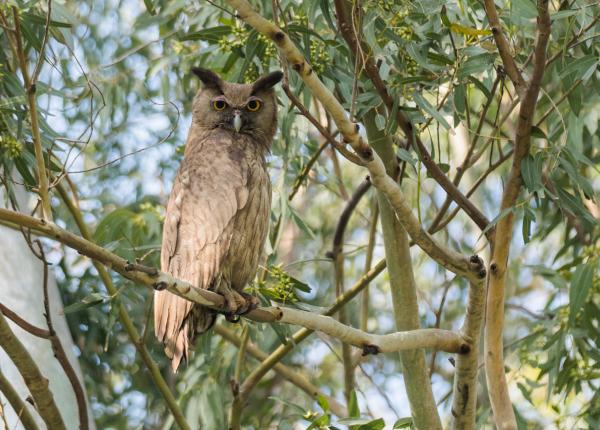Did you Know?
- There are two recognized subspecies of the Dusky Eagle-owl
- Though it has a generally wide range, this owl does not live in very arid (dry) habitats
- This owl is often active during daytime hours
- In Pakistan, biologists documented the very first case of this owl nesting on the ground
How The Peregrine Fund is Helping
Though The Peregrine Fund does not work directly with Dusky Eagle-owls, our efforts in scientific research, habitat conservation, education, and community development help conserve birds of prey around the world. We also supply literature to researchers from our avian research library, which helps scientists around the world gather and share important information on raptor conservation. Our support of the Global Raptor Information Network gives raptor researchers tools to more efficiently conduct their own studies while contributing to a global program. It also provides citizen scientists a way to participate in raptor science and conservation.
Where It Lives
This stunning owl is found through parts of Asia, including in India, Nepal and Bangladesh, among other countries. It generally prefers to make its home in flat, open habitats, very often close to water. It is a lowland species, inhabiting riparian forest, plantations, or woodlands from 0 to around 250 m in elevation.
What It Does
Dusky Eagle-owls have striking yellow eyes and long "ear tufts," which actually aren't ears at all. Though they share some resemblance to the ears of some mammals, in the Dusky Eagle-owl's case, they are simply long feathers that help with camouflage and possibly communication.
Dusky Eagle-owls are arguably one of the coolest owl species around. Their large, powerful feet and strong flight make them effective hunters. Like many raptors, these owls are top predators – they hunt other animals for food but no animals hunt them on a regular basis. They are unlike snakes, for example, which prey on mice, birds, and other animals but also are preyed upon by animals that feed on them. For most top predators, their only threat is humans. Top predators, such as the Eurasian Eagle-owl, play an important role in nature by helping to control populations of prey animals and maintain a balance in the ecosystems where they live.
Why It Needs our Help
There is a lot to learn about the biology and habits of this beautiful owl, as well as the threats it faces. Its populations appear to be in decline throughout much of its range.
What It Eats
If you picture this large owl hunting in relatively open habitat, often near water, what do you suppose it might eat? The answer is - just about anything it can catch. It will hunt other birds (and bird eggs), such as crows, pigeons parakeets, coucals, herons, coots and even other raptors. It will also feed on mammals both small and medium-sized from rats to hares, and from squirrels to porcupines. But, the long list of menu items doesn't stop there. It has also been known to prey upon reptiles, fish, amphibians, and insects!
Now, as you can image, hunting all of these different types of prey would mean that the owl has had to adopt a few different hunting styles. It has been documented hunting on the ground, walking into water, and plucking birds from perches as they roost in order to score a meal. However, this is still a lot more we have to learn about this species. It would make a wonderful study subject for a budding biologists interested in learning more about owls!
Nests, Eggs, and Young
Scientists still have a lot to learn about the breeding and nesting habits of the Dusky Eagle-owl. But here is what we do know... Many owl species do not build their own nests and the Dusky Eagle-owl is no exception. It tends to use old stick nests built by other birds in which to lay its eggs. It might use nests built by other raptors, such as kites, vultures or eagles. It usually selects a nest that has been built high in a tree, often where large branches fork. Though very rare, in India this species was documented nesting on a cliff
Once a nest site has been selected and the time is right, the female will lay between 1-3 eggs.
It is suspected that the female does most of the incubation of the eggs, but scientists don't yet know how long the incubation period is! We also don't know how long young remain in the nest, when they fly for the first time or how long they are dependent on their parents before dispersing.
Dusky Eagle-owl and the World Center for Birds of Prey
The World Center for Birds of Prey offers fun ways to learn about raptors. Interactive activities, tours, interesting videos and a children's room with activities from coloring sheets to quizzes to costumes await you. At our visitor center, you can see live owls up close - such as a Verreaux's Eagle-owl or a Western Screech-owl, and learn about the wonderful and interesting adaptations they have in order to survive in their respective habitats. There is also a touch table with owl feathers and other natural objects available for exploration. Though far from Dusky Eagle-owls habitat, if you take a stroll along a short nature trail around the center, you may come across other owl species including Barn Owls or even a Northern Saw-whet Owl perched in the trees.
References:
BirdLife International. 2016. Bubo coromandus. The IUCN Red List of Threatened Species 2016: e.T22688992A93213395. https://dx.doi.org/10.2305/IUCN.UK.2016-3.RLTS.T22688992A93213395.en. Accessed on 22 June 2023.
Holt, D. W., R. Berkley, C. Deppe, P. L. Enríquez, J. L. Petersen, J. L. Rangel Salazar, K. P. Segars, K. L. Wood, J. S. Marks, and C. Hansasuta (2022). Dusky Eagle-Owl (Ketupa coromandus), version 1.1. In Birds of the World (S. M. Billerman, P. Pyle, and N. D. Sly, Editors). Cornell Lab of Ornithology, Ithaca, NY, USA. https://doi.org/10.2173/bow.dueowl1.01.1









